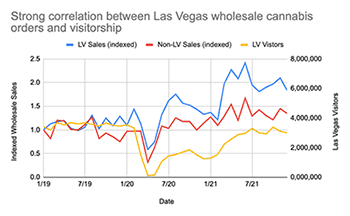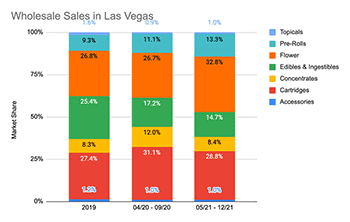A Health Insurance Program Crafted For Cannabis Businesses
Marijuana Industry News March 25, 2022 MJ Shareholders
Out of all the industries affected by the pandemic, tourism was among the hardest hit. The Las Vegas tourism economy, specifically, suffered nearly $34 billion in losses in 2020 due to the COVID-19 pandemic, according to a report by Applied Analysis for the Las Vegas Convention and Visitors Authority.
With such a significant impact on the local economy, we investigated if cannabis purchasing patterns in Las Vegas and Nevada were also affected – and they were indeed. We analyzed Nevada cannabis purchasing habits in three time periods: 2019 (pre-pandemic), April 2020 to September 2020 (the height of pandemic impact on tourism in Las Vegas), and from May 2021 to December 2021 (when tourists began returning to Las Vegas at a more normal rate).
We also compared the Market Share by Category and Competitiveness by Category during these periods to provide a more thorough analysis of how the pandemic impacted purchasing habits in Las Vegas over those three time periods.
Analyzing COVID-19’s Impact on Visitors and Wholesale Sales in Las Vegas

© LeafLink
In 2021, 63% of all wholesale cannabis sales in Nevada occurred in Las Vegas, compared to 58% in 2019. While only 21% of the state’s population lives in Las Vegas, the city generates more wholesale cannabis volume than the rest of the state combined, driven by the number of tourists. This disparity became even more significant in 2021, despite sales growing both within the city and in the rest of the state.
Across the early months of the pandemic, sales declined in both Las Vegas and the rest of the state, as did visitor volume. Cannabis sales in Las Vegas began to decline earlier than the rest of the state, dropping 21% in March 2020 while Nevada as a whole saw 0.3% growth in the month. However, that trend soon shifted, as both the city and state saw dramatic sales declines in April, decreasing by 48% in Las Vegas and 68% in the rest of the state month-over-month.
Starting just one month later in May, sales surged in Las Vegas by 27.8% in May and 76.2% in June MoM and recovered to pre-pandemic levels in the rest of the state. This trend held until September 2020, when sales decreased by 10.9% MoM. Cannabis sales in Las Vegas continued to decline throughout the remainder of 2020, while the rest of the state saw early declines between August and October, then a 14.5% increase in sales from November to December.
In February 2021, sales spiked again as the world started to “open up” – only for case numbers to surge again that spring. Las Vegas visitors were undeterred and continued to visit the city, which drove higher sales numbers in the spring. Las Vegas saw a 62.6% increase in sales in March 2021 versus February, and an additional 15.2% growth in April. That volume of visitors in Las Vegas began to decrease by July 2021, and we can see a large decline in wholesale sales starting around that point.
Overall, there is a clear relationship between visitors to Las Vegas and total cannabis sales in the city, and as the pandemic significantly impacted visitor volume, it impacted sales as well.
Impacts on Category Market Share

© LeafLink
To provide a more thorough analysis of how the pandemic impacted purchasing habits, we analyzed category market share and competitiveness over three significant periods of the pandemic (listed above) within the city.
Prerolls became more popular over the past two years. In the first quarter of 2020, prerolls represented 6.1% of the market. This percentage stayed steady in the second quarter, but then saw market share increase every subsequent quarter to reach 10% in the final quarter of 2021.
Flower saw very little change in market share from April to September 2020, then saw a dramatic increase from May to December 2021 reaching 32.8% of all wholesale sales through LeafLink.
Edibles & ingestibles significantly lost market share at the beginning of the pandemic, and actually saw additional declines as tourists returned to LV (from 25.4% of sales pre-pandemic to just 14.7% in 2021).
Concentrates and cartridges both gained market share right as visitors stopped coming to Las Vegas, but returned to pre-pandemic levels in 2021.
Topicals and accessories, our smallest categories by market share, saw declines as the pandemic started in April 2020 and market share didn’t recover as tourists returned to the city.
Conclusion
Overall, while the pandemic had a short-term negative impact on wholesale cannabis sales in Las Vegas and Nevada, the long-term outlook is promising. The city has continued to experience an increase in sales over recent months as tourists visit the city in higher numbers (69% more monthly average visitors in 2021 vs. 2020). While LV tourism hasn’t returned to pre-pandemic highs, it’s clear the cannabis industry will continue to grow as visitors return in greater numbers. With that said, we can expect more near-term volatility in wholesale sales based on the volume of visitors Las Vegas can attract.
Alex Feldman is the general manager of Insights & Marketing Services at LeafLink, where he develops products that empower cannabis businesses to make data-driven decisions and grow their reach.
MJ Shareholders
MJShareholders.com is the largest dedicated financial network and leading corporate communications firm serving the legal cannabis industry. Our network aims to connect public marijuana companies with these focused cannabis audiences across the US and Canada that are critical for growth: Short and long term cannabis investors Active funding sources Mainstream media Business leaders Cannabis consumers










